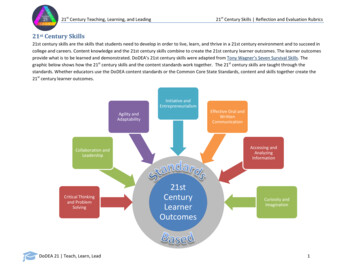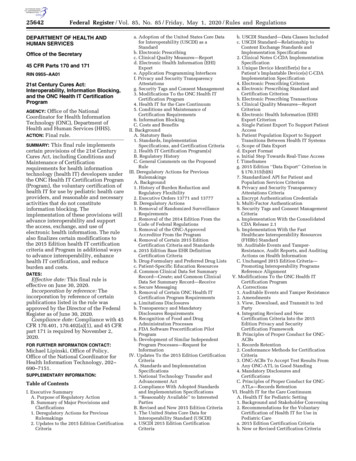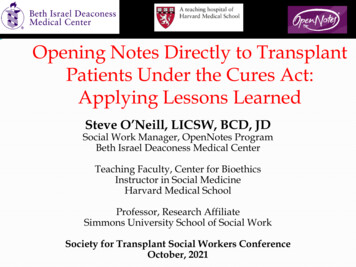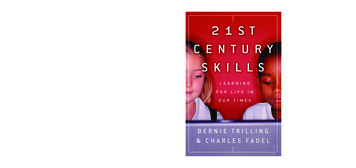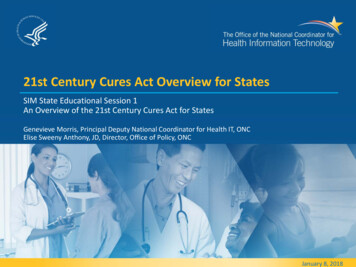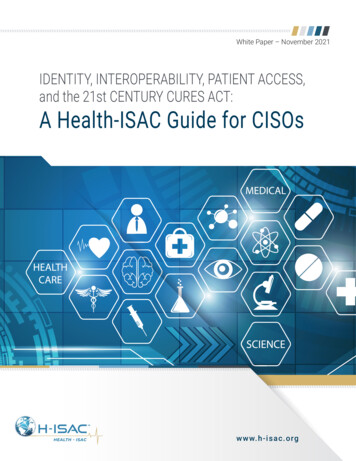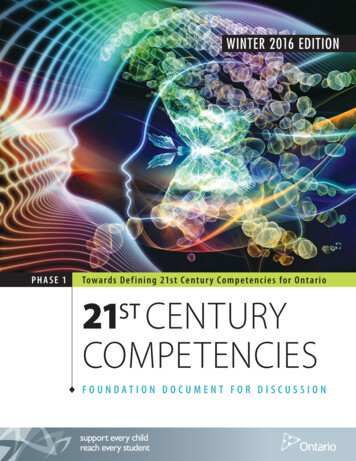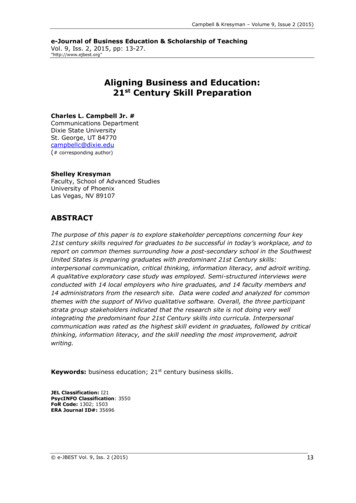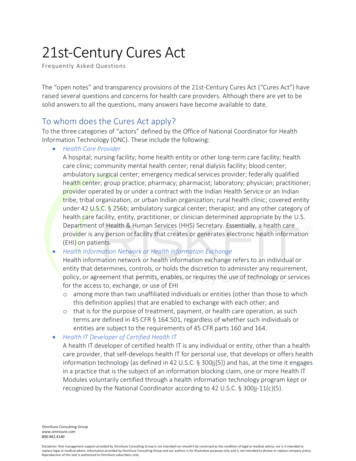
Transcription
21st-Century Cures ActFrequently Asked QuestionsThe “open notes” and transparency provisions of the 21st-Century Cures Act (“Cures Act”) haveraised several questions and concerns for health care providers. Although there are yet to besolid answers to all the questions, many answers have become available to date.To whom does the Cures Act apply?To the three categories of “actors” defined by the Office of National Coordinator for HealthInformation Technology (ONC). These include the following: Health Care ProviderA hospital; nursing facility; home health entity or other long-term care facility; healthcare clinic; community mental health center; renal dialysis facility; blood center;ambulatory surgical center; emergency medical services provider; federally qualifiedhealth center; group practice; pharmacy; pharmacist; laboratory; physician; practitioner;provider operated by or under a contract with the Indian Health Service or an Indiantribe, tribal organization, or urban Indian organization; rural health clinic; covered entityunder 42 U.S.C. § 256b; ambulatory surgical center; therapist; and any other category ofhealth care facility, entity, practitioner, or clinician determined appropriate by the U.S.Department of Health & Human Services (HHS) Secretary. Essentially, a health careprovider is any person or facility that creates or generates electronic health information(EHI) on patients. Health Information Network or Health Information ExchangeHealth information network or health information exchange refers to an individual orentity that determines, controls, or holds the discretion to administer any requirement,policy, or agreement that permits, enables, or requires the use of technology or servicesfor the access to, exchange, or use of EHIo among more than two unaffiliated individuals or entities (other than those to whichthis definition applies) that are enabled to exchange with each other; ando that is for the purpose of treatment, payment, or health care operation, as suchterms are defined in 45 CFR § 164.501, regardless of whether such individuals orentities are subject to the requirements of 45 CFR parts 160 and 164. Health IT Developer of Certified Health ITA health IT developer of certified health IT is any individual or entity, other than a healthcare provider, that self-develops health IT for personal use, that develops or offers healthinformation technology (as defined in 42 U.S.C. § 300jj[5]) and has, at the time it engagesin a practice that is the subject of an information blocking claim, one or more Health ITModules voluntarily certified through a health information technology program kept orrecognized by the National Coordinator according to 42 U.S.C. § 300jj-11(c)(5).OmniSure Consulting Groupwww.omnisure.com800.942.4140Disclaimer: Risk management support provided by OmniSure Consulting Group is not intended nor should it be construed as the rendition of legal or medical advice, nor is it intended toreplace legal or medical advice. Information provided by OmniSure Consulting Group and our authors is for illustrative purposes only and is not intended to dictate or replace company policy.Reproduction of this tool is authorized to OmniSure subscribers only.
When was the effective date of the Cures Act?Although passed in 2016, the Cures Act did not become effective until April 5, 2021. The firstattestation of compliance is April 5, 2022.What are the Cures Act Requirements?The Cures Act generally allows patients/families/guardians (hereinafter, collectively referred toas “patient”) to access, exchange, or use electronic health information (EHI). For the Americanpublic, the final rule promotes innovation in the health care technology ecosystem to deliverbetter information more conveniently to patients and clinicians. It also promotes transparency,utilizing modern computers, smartphones, and software to allow the American public to regainvisibility in the services, quality, and costs of health care.At what point in the episode of care must EHI be made available to thepatient?Draft clinical notes and laboratory results pending confirmation are examples of data points thatmay not be appropriate to disclose or exchange with the patient until finalization. However, ifsuch data is used to make health care decisions about an individual, then it would fall within the“designated record set” and therefore within the definition of EHI. To the extent that a datapoint falls within the definition of EHI, practices likely to interfere with legally permissible access,exchange, or use of that EHI may implicate the information blocking definition.A designated record falls under the following definitions:(1) A group of records maintained by or for a covered entity that includes(i) patient medical and billing records maintained by a covered health care provider;(ii) the enrollment, payment, claims adjudication, case, or medical management recordsystems maintained by or for a health plan; or(iii) those used, partly or fully, by or for the covered entity to make decisions about patients.For purposes of this paragraph, the term record means any item, collection, or grouping ofdata that include protected health information and is maintained, collected, used, ordisseminated by or for a covered entity (45 CFR § 164.501).The patient does not have real-time access to their EHI. The EHI must be at a certain stage ofcompletion before it can be accessible.What materials are required to be accessible?There are eight mandatory categories of clinical notes that must be made available to thepatient: Consultation notes Discharge summary notes History and physical examination notes Imaging narratives Lab report narrativesOmniSure Consulting Groupwww.omnisure.com800.942.4140Disclaimer: Risk management support provided by OmniSure Consulting Group is not intended nor should it be construed as the rendition of legal or medical advice, nor is it intended toreplace legal or medical advice. Information provided by OmniSure Consulting Group and our authors is for illustrative purposes only and is not intended to dictate or replace company policy.Reproduction of this tool is authorized to OmniSure subscribers only.
Pathology report narrativesProcedure notesProgress notesThe level of detail required in disclosed notes has not been finalized. It is likely true that theabove categories can be manipulated for safety. For example, rules require the disclosure of EHI.However, the name of the nurse who wrote the progress note is not EHI. The name of theprovider must be disclosed, but disclosing the names of those who took the X-ray, drew thepatient’s blood, or hung the IV line is not necessary to convey the essence of the information tothe patient. Additionally, crude, unflattering, or defamatory language should never be in amedical record revealed to the patient. In short, the record revealed to the patient should beconcise, accurate, and factual.Until October 6, 2022, EHI’s scope for the information blocking definition purposes remainslimited to the information represented by data classes and elements within the United StatesCore Data for Interoperability (USCDI). Therefore, until that date, only the notes that map theeight types specified in the “Clinical Notes” data class within the USCDI will be required inresponse to a request for legally permissible access, exchange, or use of EHI. However, actors(health care providers, health IT developers of certified health IT, and health informationnetworks or health information exchanges) should keep in mind that none of the eight clinicalnote types currently represented within the USCDI are limited based on the specialty of theprofessional who authors them.A USCDI “data class” is an aggregation of data elements by a common theme or use case. AUSCDI “data element” is the most granular level at which a piece of data is exchanged.For example, “date of birth” is a whole data element rather than its constituent day, month, oryear because the date of birth is the unit of exchange.What are “blocking” provisions?Blocking provisions impede or preclude a patient’s access to their EHI. However, there are manyvalid reasons for blocking a patient’s access to EHI listed as exemptions to the accessrequirements.What are information blocking practices?Practices considered blocking include the following: Practices that restrict authorized access, exchange, or use under applicable state orfederal law of information for treatment and other permitted purposes, includingtransitions among certified health information technologies (health IT) Implementing health IT in nonstandard ways that are likely to substantially increase thecomplexity or burden of accessing, exchanging, or using EHI Implementing health IT in ways that are likely too restrict access, exchange, or use of EHI with respect to exporting completeinformation sets or in transitioning between health IT systems; orOmniSure Consulting Groupwww.omnisure.com800.942.4140Disclaimer: Risk management support provided by OmniSure Consulting Group is not intended nor should it be construed as the rendition of legal or medical advice, nor is it intended toreplace legal or medical advice. Information provided by OmniSure Consulting Group and our authors is for illustrative purposes only and is not intended to dictate or replace company policy.Reproduction of this tool is authorized to OmniSure subscribers only.
olead to fraud, waste, abuse, or impede innovations and advancements in healthinformation access, exchange, and use, including care delivery enabled by healthITWhat are the exemptions to the rule requiring access?One of the primary exemptions to the rule requiring access is in the case of psychotherapynotes. “Psychotherapy notes means notes recorded (in any medium) by . . . a health careprovider who is a mental health professional documenting or analyzing the contents ofconversation during a private counseling session or a group, joint, or family counseling session,and that are separated from the rest of the individual’s medical record. Psychotherapy notesexcludes medication prescription and monitoring, counseling session start and stop times, themodalities and frequencies of treatment furnished, results of clinical tests, and any summary ofthe following items: Diagnosis, functional status, the treatment plan, symptoms, prognosis, andprogress to date.”Another exemption to the blocking requirement surrounds notes compiled in reasonableanticipation of or use in a civil, criminal, or administrative action or proceeding. These shouldqualify as “work products” to be protected.Other exemptions to the rule requiring access include the following: Preventing Harm ExemptionIt will not be considered information blocking if an actor engages in practices that arereasonable and necessary to prevent harm to a patient or another person, providedcertain conditions are met. Privacy ExemptionIt will not be information blocking if an actor does not fulfill a request to access,exchange, or use EHI to protect an individual’s privacy, provided certain conditions aremet. Security ExemptionIt will not be information blocking if an actor interferes with the access, exchange, or useof EHI to protect EHI security, provided certain conditions are met. Infeasibility ExemptionIt will not be information blocking if an actor does not fulfill a request to access,exchange, or use EHI due to the infeasibility of the request, provided certain conditionsare met. Health IT Performance ExemptionIt will not be information blocking if an actor takes reasonable and necessary measures tomake health IT temporarily unavailable or degrade the health IT’s performance for thebenefit of its overall performance, provided certain conditions are met.OmniSure Consulting Groupwww.omnisure.com800.942.4140Disclaimer: Risk management support provided by OmniSure Consulting Group is not intended nor should it be construed as the rendition of legal or medical advice, nor is it intended toreplace legal or medical advice. Information provided by OmniSure Consulting Group and our authors is for illustrative purposes only and is not intended to dictate or replace company policy.Reproduction of this tool is authorized to OmniSure subscribers only.
Content and Manner ExemptionIt will not be information blocking if an actor limits the content of its response or themanner in which it fulfills a request to access, exchange, or use EHI, provided certainconditions are met. Fees ExemptionIt will not be information blocking if an actor charges fees, including those that result in areasonable profit margin, for accessing, exchanging, or using EHI, provided certainconditions are met. This is true only to the extent that they comply with the “FeesExemption” (45 CFR § 171.302). For example, if the fees to export or convert data fromtechnology were not agreed to in writing at the time the technology was acquired, thenthe “Fees Exemption” would not be available, and such fees may implicate theinformation blocking definition unless another exemption applies. Licensing ExemptionIt will not be information blocking for an actor to license interoperability elements for EHIto be accessed, exchanged, or used, provided certain conditions are met.How is unlawful information blocking reported?Anyone who believes they may have experienced or observed information blocking by any healthcare provider, health IT developer of certified health IT, health information network, or healthinformation exchange is encouraged to share their concerns with ONC through the InformationBlocking Portal on ONC’s website, HealthIT.gov. Reports can be made anonymously and ONC willbegin its investigation within two (2) business days.Must a health care provider use certified health IT?The information blocking regulations do not require actors to have or use certified health ITunder the ONC Health IT Certification Program. Actors subject to information blockingregulations are not required to immediately upgrade their certified health IT (as of April 5, 2021)if they are also participating in a separate regulatory program that requires the use of certifiedhealth IT, such as CMS’s Promoting Interoperability Programs.Is a business associate subject to the Cures Act?In some instances, a business associate will be an actor under the information blockingregulation in 45 CFR part 171 and, in other situations, may not. Any individual or entity thatmeets any definition of an “actor” in the Cures Act is subject to the information blockingregulation in 45 CFR part 171, regardless of whether they are also a HIPAA-covered entity (CE) orbusiness associate (BA).How is the Cures Act enforced?Enforcement of the information blocking regulations depends upon the individual or entity thatis the subject of an enforcement action or actor. For health IT developers and health informationOmniSure Consulting Groupwww.omnisure.com800.942.4140Disclaimer: Risk management support provided by OmniSure Consulting Group is not intended nor should it be construed as the rendition of legal or medical advice, nor is it intended toreplace legal or medical advice. Information provided by OmniSure Consulting Group and our authors is for illustrative purposes only and is not intended to dictate or replace company policy.Reproduction of this tool is authorized to OmniSure subscribers only.
networks/HIEs, the HHS Office of the Inspector General is presently engaged in rulemaking toestablish enforcement dates. Currently, for health care providers, HHS must engage in futurerulemaking to establish appropriate disincentives as directed by the Cures Act.After April 5, 2021, any actor’s agreements, arrangements, or contracts are subject to and mayimplicate the information blocking regulations. Consequently, all health care providers shouldreview their contracts and agreements for health care portals and electronic medical records toensure compliance with the Cures Act. Because many health care providers are not also ITexperts, each vendor who supplies software or products that may affect EHI handling shouldsubmit a statement affirming or certifying the product’s compliance with the Cures Act.OmniSure Consulting Groupwww.omnisure.com800.942.4140Disclaimer: Risk management support provided by OmniSure Consulting Group is not intended nor should it be construed as the rendition of legal or medical advice, nor is it intended toreplace legal or medical advice. Information provided by OmniSure Consulting Group and our authors is for illustrative purposes only and is not intended to dictate or replace company policy.Reproduction of this tool is authorized to OmniSure subscribers only.
OmniSure Consulting Group www.omnisure.com 800.942.4140 Disclaimer: Risk management support provided by OmniSure Consulting Group is not intended nor should it be construed as the rendition of legal or medical advice, nor is it intended to replace legal or medical advice. Information provided by OmniSure Consulting Group and our authors is for .
